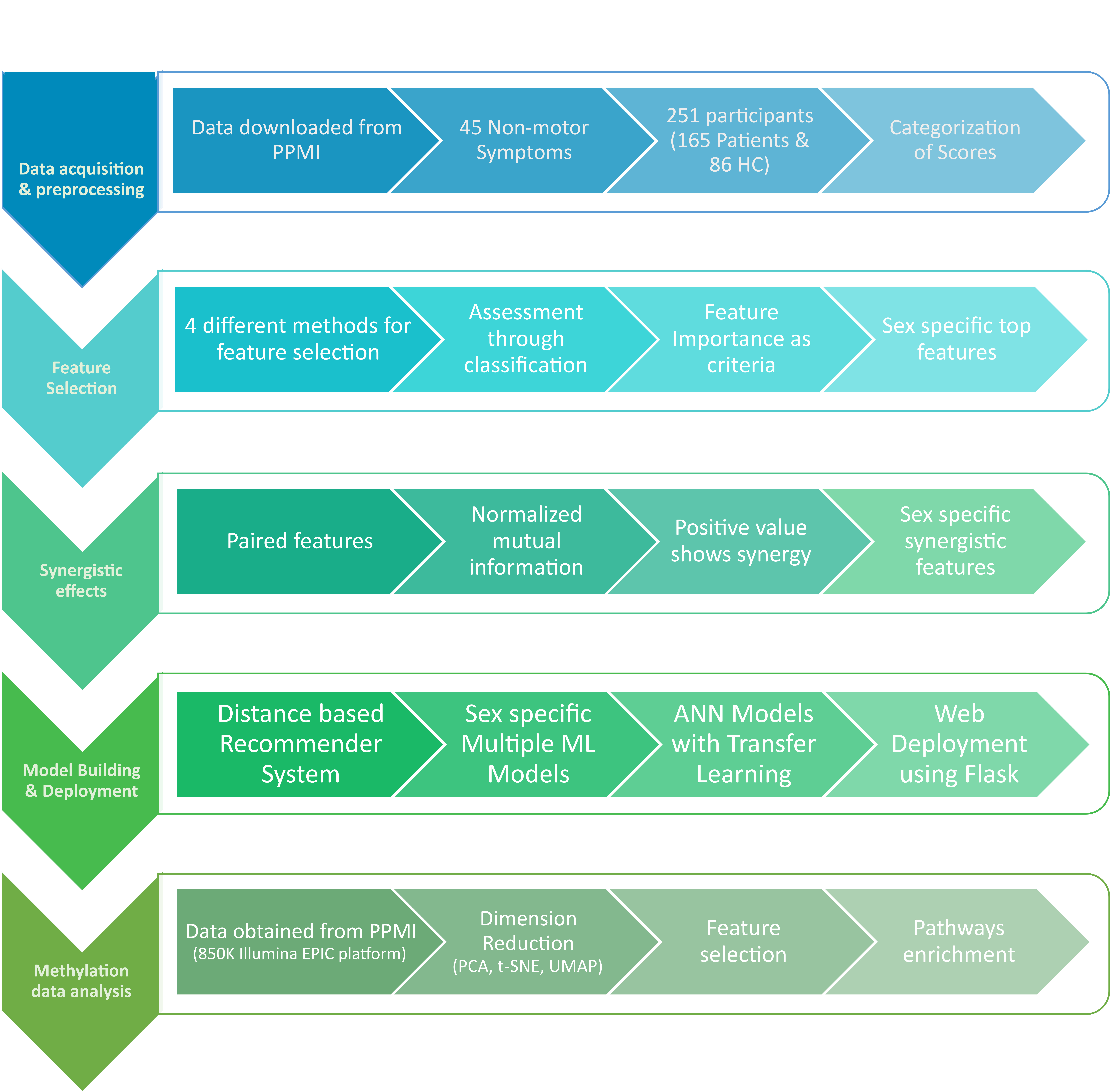Category: Parkinson's Disease: Non-Motor Symptoms
Objective: Our study aimed to develop a machine learning (ML) model for the early detection of Parkinson’s disease (PD), utilizing non-motor symptoms (NMS) and DNA methylation profiles from the Parkinson’s Progression Markers Initiative (PPMI) dataset. We aimed to construct separate ML models for male and female subjects and develop a user-friendly web tool for predicting disease risk.
Background: Early detection of Parkinson’s disease is crucial for slowing disease progression. Current methods rely on NMS and methylation profiles. We aimed to leverage these factors to improve detection accuracy. Gender-specific differences in PD presentation and progression are also noted, motivating our analysis of gender-specific data.
Method: We employed feature selection techniques to identify key NMS and analyzed gender-specific data to construct separate ML models for male and female subjects. Three ML approaches were used: a recommender system, neural network-based transfer learning, and an ensemble model comprising Support Vector Machines (SVM linear), Least Absolute Shrinkage and Selection Operator (LASSO), and elastic net algorithms. Additionally, we identified significant CpGs unique to each gender for predicting disease conditions based on beta expression values.
Results: Our study identifies distinct sets of significant or crucial features (NMS) for male and female subjects. Our ML models achieved over 80% accuracy for both male and female datasets, with robust AUC-ROC curves demonstrating excellent discriminatory performance. Additionally, we conducted pathway enrichment analysis of the important CpGs identified in our study, revealing the involvement of vital pathways associated with Parkinson’s disease. We developed a user-friendly web tool using the Flask package in Python and a JavaScript-powered front end. Users can input age, gender, and NMS scores, with the model predicting their risk category for developing Parkinson’s disease. Significant CpGs unique to each gender were identified, contributing to disease prediction accuracy.
Conclusion: NMS and gender-specific patterns are crucial in Parkinson’s disease detection. Our predictive tool has potential in complementing established clinical methodologies for diagnosis and management. Further research and validation are warranted to enhance its clinical utility.
Workflow of the study.
References: [1] Cheng HC, Ulane CM, Burke RE. Clinical progression in Parkinson disease and the neurobiology of axons. Ann Neurol
2010;67:715–25. https://doi.org/10.1002/ANA.21995.
[2] Noyce AJ, Lees AJ, Schrag AE. The prediagnostic phase of Parkinson’s disease. J Neurol Neurosurg Psychiatry 2016;87:871–
8. https://doi.org/10.1136/JNNP-2015-311890.
[3] Takahashi K. [Non-motor symptoms in premotor phase of Parkinson disease]. Rinsho Shinkeigaku 2013;53:974–6.
https://doi.org/10.5692/clinicalneurol.53.974.
[4] Schapira AHV, Chaudhuri KR, Jenner P. Non-motor features of Parkinson disease. Nat Rev Neurosci 2017;18:435–50.
https://doi.org/10.1038/NRN.2017.62.
[5] Marinus J, Zhu K, Marras C, Aarsland D, van Hilten JJ. Risk factors for non-motor symptoms in Parkinson’s disease. Lancet
Neurol 2018;17:559–68. https://doi.org/10.1016/S1474-4422(18)30127-3.
[6] by Sujata Dash E, Kumar Pani S, P C Rodrigues JJ, Majhi B. Deep Learning, Machine Learning and IoT in Biomedical and
Health Informatics; Techniques and Applications. n.d.
[7] Makarious MB, Leonard HL, Vitale D, Iwaki H, Sargent L, Dadu A, et al. Multi-modality machine learning predicting
Parkinson’s disease. Npj Parkinson’s Disease 2022 8:1 2022;8:1–13. https://doi.org/10.1038/s41531-022-00288-w.
[8] Dadu A, Satone V, Kaur R, Hashemi SH, Leonard H, Iwaki H, et al. Identification and prediction of Parkinson’s disease subtypes
and progression using machine learning in two cohorts. Npj Parkinson’s Disease 2022 8:1 2022;8:1–12.
https://doi.org/10.1038/s41531-022-00439-z.
[9] Rodriguez-Sanchez F, Rodriguez-Blazquez C, Bielza C, Larrañaga P, Weintraub D, Martinez-Martin P, et al. Identifying
Parkinson’s disease subtypes with motor and non-motor symptoms via model-based multi-partition clustering. Scientific Reports
2021 11:1 2021;11:1–10. https://doi.org/10.1038/s41598-021-03118-w.
[10] Martinez-Eguiluz M, Arbelaitz O, Gurrutxaga I, Muguerza J, Perona I, Murueta-Goyena A, et al. Diagnostic classification of
Parkinson’s disease based on non-motor manifestations and machine learning strategies. Neural Comput Appl 2023;35:5603–
17. https://doi.org/10.1007/S00521-022-07256-8/TABLES/5.
[11] Marek K, Jennings D, Lasch S, Siderowf A, Tanner C, Simuni T, et al. The Parkinson Progression Marker Initiative (PPMI).
Prog Neurobiol 2011;95:629–35. https://doi.org/10.1016/j.pneurobio.2011.09.005.
[12] Blokh D, Stambler I. The use of information theory for the evaluation of biomarkers of aging and physiological age. Mech
Ageing Dev 2017;163:23–9. https://doi.org/10.1016/J.MAD.2017.01.003.
[13] Augustine EF, Pérez A, Dhall R, Umeh CC, Videnovic A, Cambi F, et al. Sex Differences in Clinical Features of Early, Treated
Parkinson’s Disease. PLoS One 2015;10. https://doi.org/10.1371/JOURNAL.PONE.0133002.
[14] Lin SJ, Baumeister TR, Garg S, McKeown MJ. Cognitive profiles and hub vulnerability in Parkinson’s disease. Front Neurol
2018;9:482. https://doi.org/10.3389/FNEUR.2018.00482/FULL.
[15] Martinez-Martin P, Falup Pecurariu C, Odin P, van Hilten JJ, Antonini A, Rojo-Abuin JM, et al. Gender-related differences in
the burden of non-motor symptoms in Parkinson’s disease. J Neurol 2012;259:1639–47. https://doi.org/10.1007/s00415-011-
6392-3.
[16] Cerri S, Mus L, Blandini F. Parkinson’s Disease in Women and Men: What’s the Difference? J Parkinsons Dis 2019;9:501–15.
https://doi.org/10.3233/JPD-191683.
To cite this abstract in AMA style:
MZA. Ali, PSD. Dholaniya. Integrating Non-Motor Symptoms and Gender Variability in Machine Learning for Early Parkinson’s Disease Detection [abstract]. Mov Disord. 2024; 39 (suppl 1). https://www.mdsabstracts.org/abstract/integrating-non-motor-symptoms-and-gender-variability-in-machine-learning-for-early-parkinsons-disease-detection/. Accessed December 14, 2025.« Back to 2024 International Congress
MDS Abstracts - https://www.mdsabstracts.org/abstract/integrating-non-motor-symptoms-and-gender-variability-in-machine-learning-for-early-parkinsons-disease-detection/

